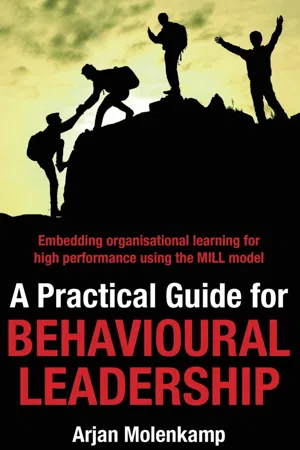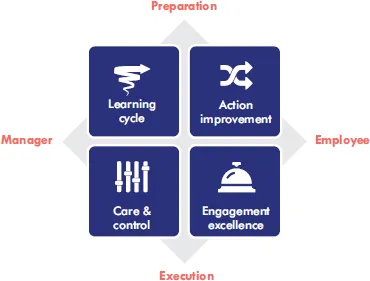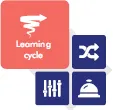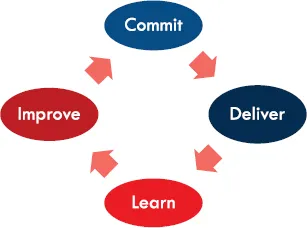![]()
PART 1:
THE MILL MODEL
The first part of this book will give you a high-level overview of the MILL model. The graph may look a bit overwhelming, but understanding how the various parts of this book are interconnected will make it easier to dig deeper into these parts. The key messages for the book are as follows:
•Part 3: The manager should be able to organise a learning-by-doing environment to get the best out of employees and teams.
•Part 4: The employees should be able to identify areas for improvement and understand what kind of change is required to develop new skills and competencies.
•Part 5: The employee can learn most during daily engagements if there is a structured approach aiming for receiving feedback on every step in the process.
•Part 6: The manager has to follow up and give feedback and show care and control to support and stretch employees for continuous learning and increasing results.
•To connect and support these parts, there are still two additional parts that are required to make the whole model work properly and sustainable:
•Part 2: The parts 3 to 6, also called the blades, will be connected by guiding tools and key principles as described in this part
•Part 7: This part will describe four organisational requirements that should be in place as foundation for a successful implementation of the MILL model.
OVERVIEW OF THE MILL MODEL
The manager initiates the learning cycle by seeking commitment from employees on action improvement. Commitments will then be executed using the engagement excellence approach, during which time the manager will stay involved by showing care and control.
Applying the MILL model will facilitate organisational learning that will result in higher performance.
In traditional management, the manager is more focussed on preparation and the employee is primarily involved in execution. The MILL model does not have such a split, as both managers and employees have a role to play in execution and preparation.
The outcome of using the MILL model is more empowerment and more impact for better results!
![]()
CHAPTER 1 :
OVERVIEW OF THE MILL MODEL
‘Yesterday is gone. Tomorrow has not yet come.
We have only today.
Let us begin.’
MOTHER TERESA (ATTRIBUTED)
The MILL model is constructed of four sectors, or ‘blades’, that work together to help an organisation become a Learning High Performing Organisation (LHPO). Each blade is constructed of several building blocks, which make up the day-to-day focus for an organisation. The four blades are connected by a set of key tools and guiding principles that ensure that the entire mechanism works together. Let’s take a look at each of these components.
•The first blade of the MILL model is the learning cycle and explains the role of managers in guiding the whole learning process for both the employees and themselves. The manager is the overall owner of the learning cycle and facilitates the process. Stretching employees and getting clear commitment from them will be followed up by improved actions with a focus on delivery. The manager has to support and stimulate the process of learning from both successes and failures, and those lessons provide input for another round of improvement in the next learning cycle.
•The second blade is called action improvement, and describes what is expected from employees in terms of coming up with ideas for action improvements (behavioural change). Employees’ ideas should be based on what they have learned so far or what they want to explore to see whether it works. These ideas can be grouped in categories related to quantity of work (more work) and quality of work (better work). To find the time for stretching and to explore other opportunities, staff will also be challenged to see what can be done in two more categories: doing things differently (creativity) or doing things less (efficiency).
•Engagement excellence is the third blade of the model and describes how the first two blades can be used for daily engagements and what specific steps are required to learn and improve after each engagement. Employees are guided how to structure engagement with their stakeholders (customers, colleagues or others) in such a way that best results will be achieved and best input for learning will be collected. The focus during these engagements is on customer needs, followed by managing expectations and checking whether needs are well understood. Execution will be aligned with these needs and expectations, and afterwards there will be an assessment of the overall experience as input for learning and improvement.
•The last blade of the MILL model is care and control. This will explain that the role of the manager is to stay involved and get the best out of both the individual employees and the team. The manager has a duty to show daily care and control towards employees in order to support and stretch them for continuous learning. Driving results and grooming employees goes hand-in-hand with identifying the strengths and weaknesses of individuals, as well as exploring organisational opportunities for further improvement. An employee’s progress and the impact of their work are used for analysis and feedback to help them fulfil their potential, which is in the best interest of all stakeholders.
The four blades of the MILL model are connected by a set of key tools and guiding principles. With the support of these tools and principles, the blades can mutually reinforce each other.
•The first tool is the action improvement meeting (AIM) and connects the learning cycle with action improvement. The process of turning employees’ ideas for action improvement into firm commitments will be done during these meetings. During the meeting it will be made clear what the actions will look like, but also what results are expected. The action improvement meeting takes place on a weekly basis and requires the involvement of all team members under the guidance of the manager.
•Execute or escalate is the guiding principle that connects action improvement with engagement excellence and is a primary focus for employees. This principle is introduced to make sure that employees are serious about their commitments. The manager is not supposed to waste time by micro-managing employees and checking whether they stick to their commitment. Employees have a duty to let the manager know if there is any reason for not sticking to their action improvement commitment when executing engagement excellence.
•The action card and result board are key tools that work together to connect engagement excellence to care and control. During the week, employees are required to track activities and achievements to measure progress and do some analysis on what worked well and what did not work well. This kind of tracking also helps the manager to have meaningful interventions with their employees. The manager is supposed to guide the learning process, and therefore has to see how effort and impact differ between employees.
•The principle of inspect what you expect connects the learning cycle with care and control and is the focus for management. While the execute or escalate principle provides employees with their own link between preparation and execution, the manager also has to show that he or she is serious by applying care and control when implementing the learning cycle. The manager’s principle is called ‘inspect what you expect’ and it urges managers to ‘put their money where their mouth is’ by being involved and showing care for what they claim is important.
In the next chapter we will look in more detail at the building blocks of each blade of the model, which will be fully unpacked and discussed in Parts 3–6. It is important to understand the whole model before zooming in on the blades, and thereafter zooming in further on the building blocks of the blades. Once the bigger picture is understood, then zooming in will provide examples on how to make the model work.
THE LEARNING CYCLE
(MANAGER/PREPARATION)
The learning cycle requires strong upfront commitment from employees on action goals and result goals; strong focus is required to achieve the best results. The MILL model aims for a tangible outcome, hence the focus on delivery. Both results and lessons learned are acceptable deliverables. Understanding what worked and what did not work is both considered to be a successful outcome of engagement to continue the learning cycle.
Learning is about measuring and understanding how outcome is related to effort. This will give a better insight of how impact was created and what are the root causes of failures. These learnings will be used by employees as input for the development of new ideas for further improvement. The best ideas are selected and made more specific before the cycle starts afresh by creating new commitment for another learning cycle.
![]()
CHAPTER 2 :
THE LEARNING CYCLE
‘Excellent firms do not believe in excellence, only in constant improvement and constant change.’
TOM PETERS
The first blade of the MILL model is the learning cycle. The uni...





